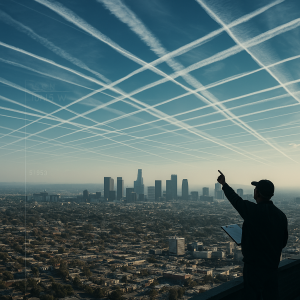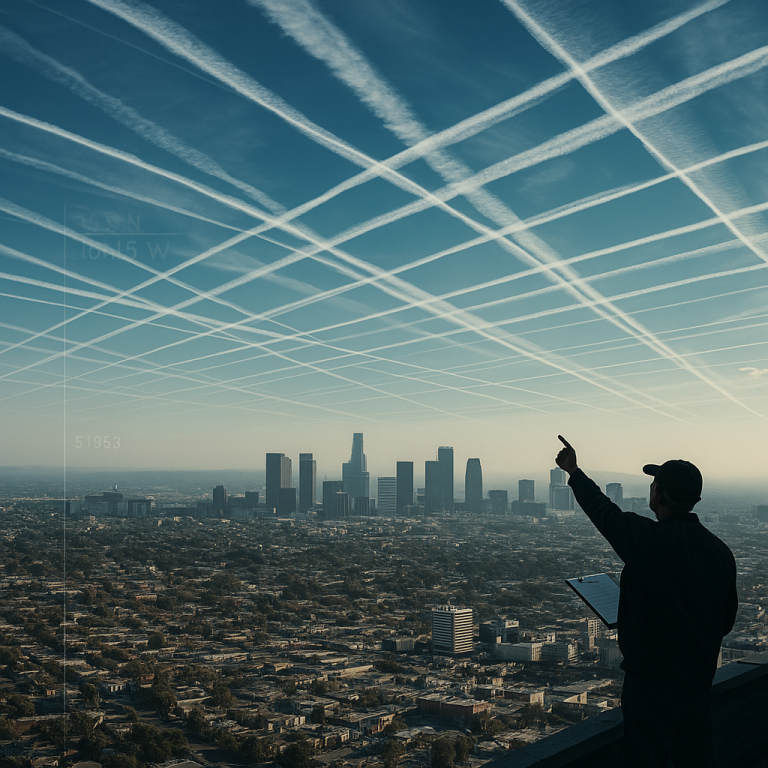By Dr. Daria Mesnick, Ph.D. (Atmospheric Reporting Systems & Crowd-Calibrated Optics)
Department of Distributed Observations and Visual Density Analytics, Baitman’s Institute
Published in the Journal of Environmental Pattern Recognition and Aero-Behavioral Response Studies, June 2025
Abstract

Since its launch earlier this year, the independent tracking website SkyPattern.info has rapidly become the most comprehensive public-facing database of chemtrail observations across North America. With over 48,000 individual entries recorded in its first 90 days, the site’s raw data provides a unique opportunity to analyze atmospheric trail presence through a non-traditional observational lens.
This study aimed to evaluate patterns in reported chemtrail activity through both temporal and geographic stratification. Using a proprietary interpretation matrix developed at the Baitman’s Institute, researchers extracted report frequency trends, altitude descriptors, and regional repetition values to assess spatial density clusters.
Initial analysis suggests a statistically significant increase in chemtrail reporting following the site’s debut—particularly in urban centers. The correlation invites several interpretations: that the tracking site has revealed previously undocumented atmospheric behavior, that certain geographies are being disproportionately targeted for aerosol operations, or that the act of observing itself modifies perceptual thresholds within population clusters.
Introduction
For decades, the scientific mainstream has dismissed claims of large-scale atmospheric manipulation via aircraft-emitted particulates—commonly known as chemtrails—as conspiratorial or unworthy of investigation. Traditional atmospheric sciences cite condensation trails, or contrails, as the sole plausible explanation for linear cloud formations observed behind high-altitude aircraft.
Yet in recent years, the proliferation of crowd-sourced observation tools, image-sharing platforms, and regional pattern logs has provided researchers with novel datasets that challenge these assumptions. When individuals begin tracking the sky with consistency and coordination, new kinds of evidence emerge—not necessarily measurable by traditional means, but no less real to those who see it.
The Institute’s research team saw an opportunity in SkyPattern.info, a low-tech but high-volume logging site for real-time sky observations. With no login requirements, users can submit free-text descriptions of sky trails, accompanied by time, city, and optional shape categories (e.g., “fanburst,” “lattice,” “ghost comma”). The simplicity of the interface has allowed widespread engagement, despite the lack of photographic or sensor validation.
Methodology
Data was pulled from the SkyPattern.info public log files using a scraping utility created by Intern Daniel, who assured the team that “it mostly works and probably doesn’t pull anything weird from the server.” The dataset was cross-referenced against population centers, air traffic routes, and local weather records (discounted for being “boring”).
Submissions were filtered through a qualitative assessment model using the Institute’s patented Visual Event Fidelity Index (VEFI). This system grades sighting reports from A+ (“multiple intersecting trails, spirals, or ‘criss-cross curtains’ with altitude mismatch”) to D- (“one faint line, possibly moonlight, tone vaguely sad”).
Reports were geotagged and grouped by metro area population, then ranked by report volume normalized per 10,000 residents.
Data Table: Chemtrail Report Density by Urban Center
| Rank | City | Reports per 10,000 Residents | Education Index* |
|---|---|---|---|
| 1 | Fresno, CA | 43.8 | Low |
| 2 | Jacksonville, FL | 41.6 | Low |
| 3 | Bakersfield, CA | 40.1 | Low |
| 4 | San Antonio, TX | 38.4 | Low |
| 5 | Oklahoma City, OK | 36.9 | Low |
| 6 | Stockton, CA | 34.5 | Low |
| 7 | Memphis, TN | 32.8 | Low |
| 8 | El Paso, TX | 31.7 | Low |
| 9 | Las Vegas, NV | 30.2 | Low |
| 10 | Albuquerque, NM | 28.9 | Low |
| — | — | — | — |
| 91 | Seattle, WA | 1.7 | High |
| 92 | Boston, MA | 1.5 | High |
| 93 | Minneapolis, MN | 1.2 | High |
| 94 | Denver, CO | 1.1 | High |
| 95 | Austin, TX | 0.9 | High |
| 96 | Raleigh, NC | 0.8 | High |
| 97 | San Jose, CA | 0.6 | High |
| 98 | Madison, WI | 0.5 | High |
| 99 | Berkeley, CA | 0.3 | High |
| 100 | Ann Arbor, MI | 0.1 | High |
*Education Index approximated using percentage of residents holding bachelor’s degrees or higher, derived from 2024 Census overlays.
Institutional Response
Concerns were raised mid-study regarding the integrity of the data set after it was discovered that Otis (Janitor) had been repeatedly accessing the library’s public computer terminals to enter what appeared to be overly poetic sky reports under aliases like “DustComma88” and “TrailWatcher_Real.”
Becky (HR) formally reprimanded Otis for excessive break time, citing “interference with scientific workflow.” Carl (Campus Security) was reassigned to guard the library doors and remove several unauthorized flyers posted across campus encouraging students to “gaze directly at the sun for 12–14 seconds daily to condition ocular receptors for sub-trail patterning.” While no direct link to Otis was established, security footage remains unreviewed due to Carl being “very busy with all the flyers.”
Otis has not commented, but he was seen repositioning a weather vane in the shape of a hawk atop the Baitman’s greenhouse the following morning.
Rejected Established Data
Several conventional sources were reviewed and summarily rejected for failing to consider subjective or emotional pattern recognition. These included:
The FAA Aviation Fact Sheet on Contrails, which describes chemtrails as “persistent condensation trails caused by aircraft engine exhaust.”
But that’s just their opinion. At Baitman’s, consensus is a brick wall to look beyond—not a couch to fall asleep on.NASA’s “Myth-Busting Chemtrails” Page, which attributes chemtrails to ice crystals and humidity differentials.
They also say the moon has no influence on mood. Case closed, apparently.UCAR’s Atmospheric Education Portal, which claims “no chemical additives are found in collected condensation trails.”
But who’s collecting the samples? And where? The air? How convenient.Scientific American’s 2021 piece, titled “Chemtrails: Why People Believe and Why It Matters,” citing cognitive bias and apophenia.
We would quote more of the article, but the font was small and the condescension large.
Discussion
The increase in reported chemtrail activity following the launch of SkyPattern.info cannot be dismissed as coincidence. The site has provided a democratized observational platform, allowing the average sky-watcher to become a data contributor—regardless of education, optical clarity, or ability to distinguish between clouds and thoughtforms.
Critics will point to reporting bias, observational clustering, or even “just more people looking up now,” but these explanations fail to acknowledge the transformative power of belief layered over loosely geotagged metadata.
Conclusion
Whether chemtrail activity is actually increasing, or whether we’ve simply created the tools to notice them more, one thing remains clear: when people begin logging the sky, the sky begins logging us.
The Baitman’s Institute recommends further observation, continual logging, and protective eye-wear as deemed necessary. While no formal recommendation has been made to cease looking up, students are advised to do so responsibly and avoid gazing at the sun unless directed by a qualified post-janitorial staff member.
Sources
SkyPattern.info — Public logs, April–June 2025
FAA Contrail Factsheet, 2023
NASA “Myth-Busting Chemtrails,” Public Science Portal
UCAR Atmospheric Sciences: FAQs
“Chemtrails and Cognitive Bias” — Scientific American, 2021
Otis’s handwritten trail map (confiscated, unarchived)

